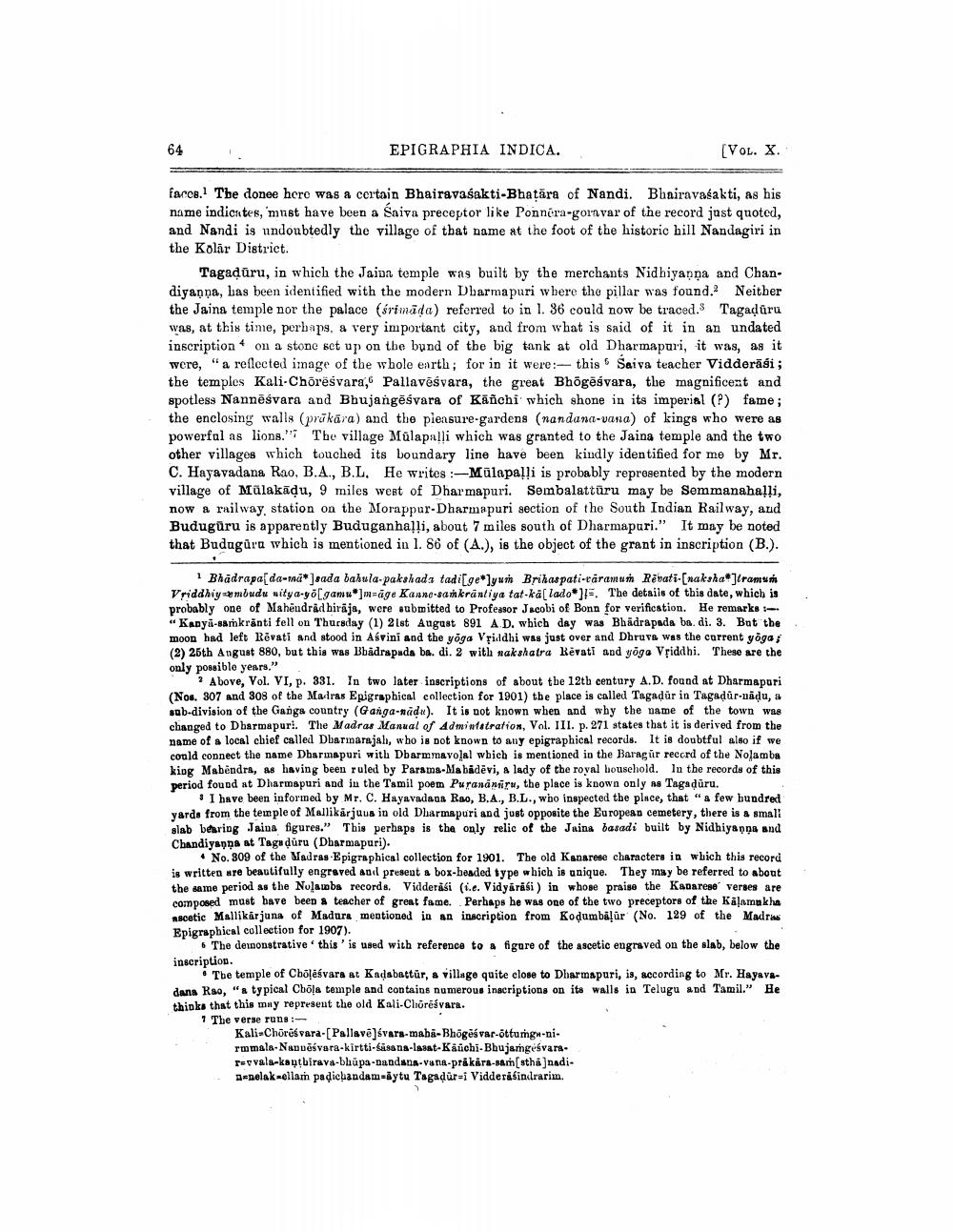________________
64
EPIGRAPHIA INDICA.
(VOL. X.
faccs.Tbe donee here was a certain Bhairavašakti-Bhatāra of Nandi. Bhairavasakti, as his name indientes, 'must have been a Saiva preceptor like Ponnora-goravar of the record just quoted, and Nandi is undoubtedly the village of that name at the foot of the historic bill Nandagiri in the Kolar District.
Tagadūru, in which the Jaisa temple was built by the merchants Nidhiyanna and Chan. diyaņņa, has been identified with the modern Dharmapuri where the pillar was found. Neither the Jaina temple nor the palace (srimāda) referred to in 1. 36 could now be traced. Tagaduru was, at this time, perbaps, a very important city, and from what is said of it in an undated inscription on a stone sct up on the bund of the big tank at old Dharmapuri, it was, as it were, "a reflected image of the whole earth; for in it were: - this Saiva teacher Vidderāśi; the temples Kali-Chöreśvara, Pallavēśvara, the great Bhögēsvara, the magnificent and spotless Nannēsvara and Bhujangēśvara of Kāichi which shone in its imperial (?) fame; the enclosing walls (prikära) and the pleasure-gardens (nandana-vana) of kings who were as powerful as lions.'' The village Mūlapalli which was granted to the Jaina temple and the two other villages which touched its boundary line have been kindly identified for me by Mr. C. Hayavadana Rao, B.A., B.L. He writes :-Mülapalli is probably represented by the modern village of Mülakādu, 9 miles west of Dharmapuri. Sembalattūru may be Semmanahalli, now a railway station on the Morappur-Dharmapuri section of the South Indian Railway, and Budugūru is apparently Buduganhalli, about 7 miles south of Dharmapuri." It may be noted that Budugūra which is mentioned in 1. 80 of (A.), is the object of the grant in inscription (B.).
1 Bhadrapa[da-na*]sada bahula-pakshada tadi ge*lyum Brihaspati-raram un Rērati-[nakshatramun Vriddhiyambudu wity a-yogamu*]mn-äge Kanne-sankrantiya tat-ka[lado*]!=. The details of this date, which is probably one of Mahendrad birāja, were submitted to Professor Jacobi of Bonn for verification. He remarks :"Kanya-samkrānti fell on Thursday (1) 21st August 891 AD. which day was Bhadrapada ba.di. 3. But the moon had left Révati and stood in Asvini and the yoga Vriddhi was just over and Dhruve was the current yoga (2) 25th Angust 880, but this was Bbädrapada be. di. 2 with nakshatra Rēvati and yoga Vșiddhi. These are the only possible years."
? Above, Vol. VI, p. 331. In two later inscriptions of about tbe 12th century A.D. found at Dharmapuri (Nos. 307 and 308 of the Malras Epigraphical collection for 1901) the place is called Tagadür in Tagadūr-nādu, a sub-division of the Ganga country (Ganga-nadu). It is not known when and why the name of the town was changed to Dharmapurl. The Madras Manual of Administration, Vol. III. p. 271 states that it is derived from the name of a local chief called Dbarmarajah, who is not known to any epigraphical records. It is doubtful also if we conld connect the name Dharmapuri with Dbarm mavolal which is mentioned in the Baragur reccrd of the Nolamba kiog Mabēndra, as having been ruled by Parama-Ma bådēvi, a lady of the royal household. In the records of this period found at Dharmapuri and in the Tamil poem Purananaru, the place is known only as Tagadūru.
I have been informed by Mr. C. Hayavadana Rao, B.A., B.L., who inspected the place, that "a few hundred yards from the temple of Mallikarjuus in old Dharmapuri and just opposite the European cemetery, there is a small slab bearing Jaina figures." This perhaps is the only relic of the Jaina basadi built by Nidhiyappa and Chandiyaņņa at Tagadūru (Dharmapuri).
• No. 309 of the Madras-Epigraphical collection for 1901. The old Kanarese characters in which this record is written are beautifully engraved and present a box-headed type which is unique. They may be referred to about the same period as the Nolacobs records. Vidderasi (ie. Vidyārāśi) in whose praise the Kauarese verses are composed must have been a teacher of great fame. Perhaps he was one of the two preceptors of the Kalamukha ascetic Mallikarjuna of Madura mentioned in an inscription from Kodumbaur (No. 129 of the Madras Epigraphical collection for 1907).
6 The demonstrative this' is used with reference to a figure of the ascetic engraved on the slab, below the inscription.
i The temple of Cböļeśvara at Kadabactür, a village quite close to Dharmapuri, is, according to Mr. Hayavadana Rao, "a typical Cbo!a temple and contains numerous inscriptions on its walls in Telugu and Tamil." He thinks that this may represent the old Kali-Chörēšvara. 1 The verse runs :
Kali-Chörösvara-[Pallavē]śvara-maba-Bhögesvar-õttung -nirmmala-Napvēsvara-kirtti-Sasana-lasat-Käuchi-Bhujangesvara. ravvala-kaytirava-bhūpa-Dandana-vana-pråkära samsthaandiAenelak=ellam padichandam=äytu Tagadür-i Vidderafindrarim.




